HOTPOINT CG64SG1 User Manual [fr]

Operating Instructions
COOKER
Contents
GB
|
|
|
|
|
|
Installation, 2-6 |
GB |
|
FR |
|
ES |
|
|
|
|
|
Positioning and levelling |
|||
|
|
|
|
|
|
Electrical connection |
English,1 |
|
|
|
|
||
Français, 13 |
Espanol, 25 |
Gas connection |
||||
|
|
|
|
|
|
Adapting to different types of gas |
GB |
|
AR |
|
|
|
Technical data |
|
|
|
|
Table of burner and nozzle specifications |
||
|
|
|
|
|
|
Description of the appliance, 7 |
English,37 |
|
|
|
|
||
|
|
|
|
|
|
Overall view |
|
|
|
|
|
|
Control panel |
|
|
|
|
|
|
Start-up and use, 8-10 |
|
|
|
|
|
|
Using the hob |
|
|
|
|
|
|
Using the oven |
|
|
|
|
|
|
Oven cooking advice table |
CG64SG1 EX |
|
|
Precautions and tips, 11 |
|||
|
|
|
|
|
|
General safety |
|
|
|
|
|
|
Disposal |
|
|
|
|
|
|
Respecting and conserving the environment |
Care and maintenance, 12
Switching the appliance off
Cleaning the appliance
Replacing the oven light bulb
Gas tap maintenance
Assistance
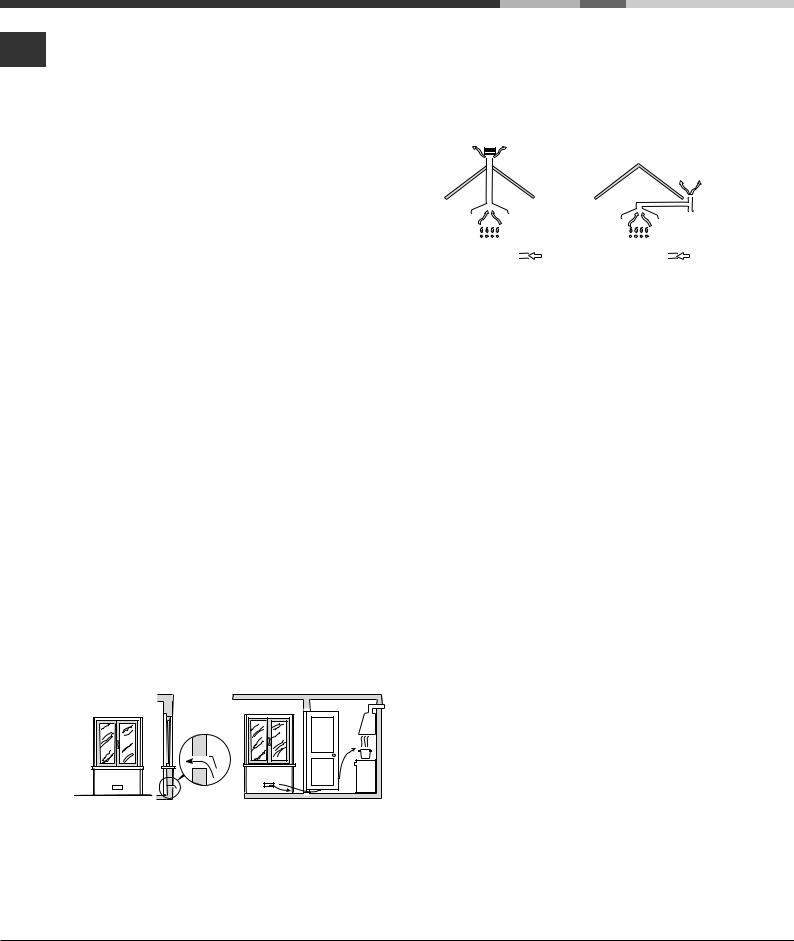
Installation
Before operating your new appliance please read GB this instruction booklet carefully. It contains
important information concerning the safe installation and operation of the appliance.
Please keep these operating instructions for future reference. Make sure that the instructions are kept with the appliance if it is sold, given away or moved.
The appliance must be installed by a qualified professional according to the instructions provided.
Any necessary adjustment or maintenance must be performed after the cooker has been disconnected from the electricity supply.
Room ventilation
The appliance may only be installed in permanentlyventilated rooms, according to current national legislation. The room in which the appliance is installed must be ventilated adequately so as to provide as much air as is needed by the normal gas combustion process (the flow of air must not be lower than 2 m3/h per kW of installed power).
The air inlets, protected by grilles, should have a duct with an inner cross section of at least 100 cm2 and should be positioned so that they are not liable to even partial obstruction (see figure A).
These inlets should be enlarged by 100% - with a minimum of 200 cm2 - whenever the surface of the hob is not equipped with a flame failure safety device. When the flow of air is provided in an indirect manner from adjacent rooms (see figure B), provided that these are not communal parts of a building, areas with increased fire hazards or bedrooms, the inlets should be fitted with a ventilation duct leading outside as described above.
Adjacent room |
Room requiring |
|
ventilation |
A B
A
|
|
|
|
|
|
|
|
|
|
|
|
|
|
Increase in the gap |
|||
Ventilation opening |
||||||||
|
|
|
||||||
for comburent air |
between the door and |
|||||||
|
|
|
||||||
|
|
|
|
|
the flooring |
|||
After prolonged use of the appliance, it is advisable to open a window or increase the speed of any fans used.
Disposing of combustion fumes
The disposal of combustion fumes should be guaranteed using a hood connected to a safe and efficient natural suction chimney, or using an electric fan that begins to operate automatically every time the appliance is switched on (see figure).
|
|
|
|
|
|
|
|
|
|
|
|
|
|
|
|
|
|
|
|
|
|
|
|
|
|
|
|
|
|
|
|
|
|
|
|
|
|
|
|
|
|
|
|
|
|
|
|
|
|
|
|
|
|
|
|
|
|
|
|
|
|
|
|
|
|
|
|
|
|
|
|
|
|
|
|
|
|
|
|
|
|
|
|
|
|
|
|
|
|
|
|
|
|
|
|
|
|
|
|
|
|
|
|
|
|
|
|
|
|
|
|
|
|
|
|
|
|
|
|
|
|
|
|
|
|
|
|
|
|
|
|
|
|
|
|
|
|
|
|
|
|
|
|
|
|
|
|
|
|
|
|
|
|
|
|
|
|
|
|
|
|
Fumes channelled |
Fumes channelled through |
||||||||||||||||
straight outside |
a chimney or a branched |
||||||||||||||||
|
|
|
|
|
|
|
|
|
|
flue system (reserved for |
|||||||
|
|
|
|
|
|
|
|
|
|
cooking appliances) |
|||||||
The liquefied petroleum gases are heavier than air and collect by the floor, therefore all rooms containing LPG cylinders must have openings leading outside so that any leaked gas can escape easily.
LPG cylinders, therefore, whether partially or completely full, must not be installed or stored in rooms or storage areas that are below ground level (cellars, etc.). Only the cylinder being used should be stored in the room; this should also be kept well away from sources of heat (ovens, chimneys, stoves) that may cause the temperature of the cylinder to rise above 50°C.
Positioning and levelling
It is possible to install the appliance alongside cupboards whose height does not exceed that of the hob surface.
Make sure that the wall in contact with the back of the appliance is made from a non-flammable, heatresistant material (T 90°C).
To install the appliance correctly:
•Place it in the kitchen, dining room or the bed-sit (not in the bathroom).
•If the top of the hob is higher than the cupboards, the appliance must be installed at least 600 mm away from them.
•If the cooker is installed underneath a wall cabinet, there must be a minimum distance of 420 mm between this cabinet and the top of the hob.
This distance should be increased to 700 mm if the wall cabinets are flammable (see figure).
2
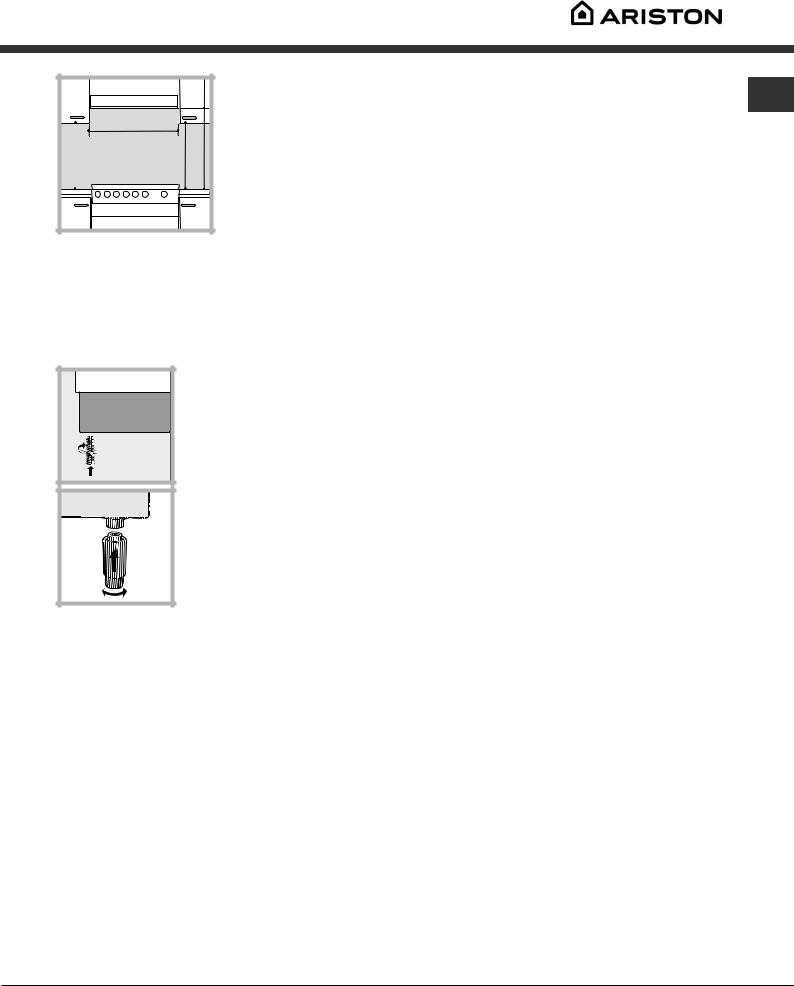
HOOD
|
Min. 600mm. |
min. 650 mm. with hood min. 700 mm. without hood |
Min. 420mm. |
Min. 420mm. |
•Do not position blinds behind the cooker or less than 200 mm away from its sides.
•Any hoods must be installed according to the instructions listed in the relevant operating manual.
Levelling
If it is necessary to level the appliance, screw the adjustable feet into the places provided on each corner of the base of the cooker (see figure).
The legs* fit into the slots on the underside of the base of the cooker.
Electrical connection
Install a standardised plug corresponding to the load indicated on the appliance data plate (see Technical data table).
The appliance must be directly connected to the mains using an omnipolar circuit-breaker with a minimum contact opening of 3 mm installed between the appliance and the mains. The circuit-breaker must be suitable for the charge indicated and must comply with current national legislation (the earthing wire must not be interrupted by the circuit-breaker). The supply cable must be positioned so that it does not come into contact with temperatures higher than 50°C at any point.
Before connecting the appliance to the power supply, make sure that:
•The appliance is earthed and the plug is compliant with the law.
•The socket can withstand the maximum power of the appliance, which is indicated by the data plate.
* Only available in certain models
• The voltage is in the range between the values |
GB |
|
indicated on the data plate. |
||
|
•The socket is compatible with the plug of the appliance. If the socket is incompatible with the plug, ask an authorised technician to replace it. Do not use extension cords or multiple sockets.
Once the appliance has been installed, the power supply cable and the electrical socket must be easily accessible.
The cable must not be bent or compressed.
The cable must be checked regularly and replaced by authorised technicians only.
The manufacturer declines any liability should these safety measures not be observed.
Gas connection
Connection to the gas network or to the gas cylinder may be carried out using a flexible rubber or steel hose, in accordance with current national legislation and after making sure that the appliance is suited to the type of gas with which it will be supplied (see the rating sticker on the cover: if this is not the case see below). When using liquid gas from a cylinder, install a pressure regulator which complies with current national regulations. To make connection easier, the gas supply may be turned sideways*: reverse the position of the hose holder with that of the cap and replace the gasket that is supplied with the appliance.
Check that the pressure of the gas supply is consistent with the values indicated in the Table of burner and nozzle specifications (see below). This will ensure the safe operation and durability of your appliance while maintaining efficient energy consumption.
Gas connection using a flexible rubber hose
Make sure that the hose complies with current national legislation. The internal diameter of the hose must measure: 8 mm for liquid gas supply; 13 mm for methane gas supply.
Once the connection has been performed, make sure that the hose:
•Does not come into contact with any parts that reach temperatures of over 50°C.
•Is not subject to any pulling or twisting forces and that it is not kinked or bent.
•Does not come into contact with blades, sharp corners or moving parts and that it is not compressed.
3
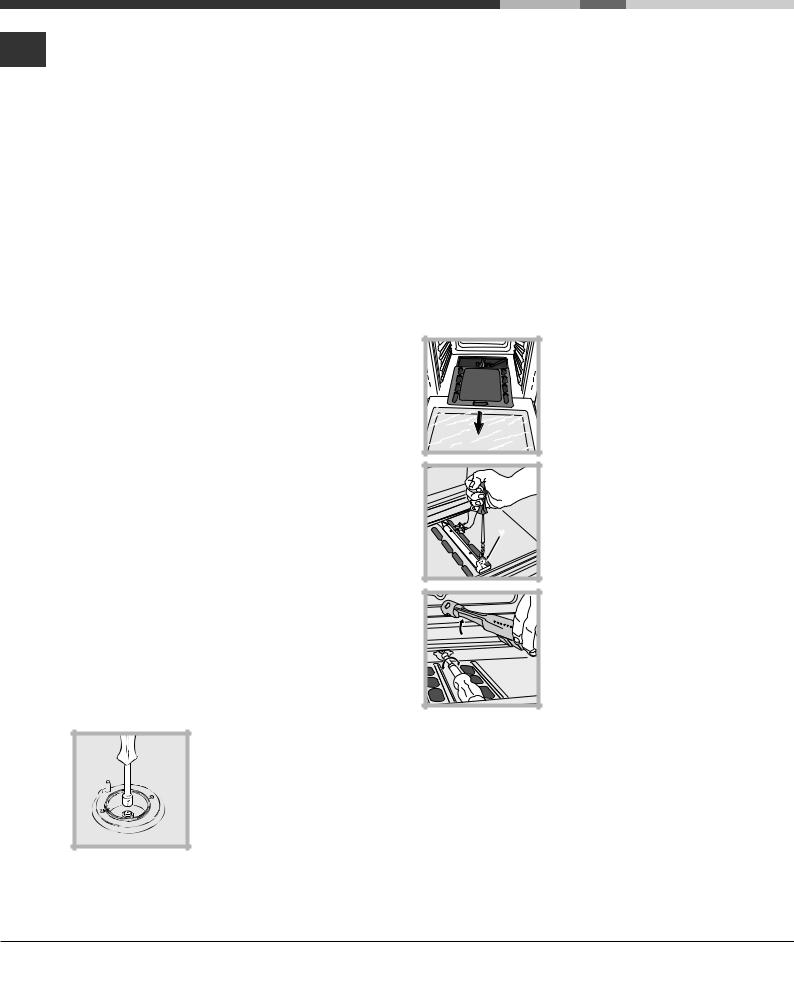
• |
Is easy to inspect along its whole length so that |
GB |
its condition may be checked. |
•Is shorter than 1500 mm.
•Fits firmly into place at both ends, where it will be fixed using clamps that comply with current regulations.
If one or more of these conditions is not fulfilled or if the cooker must be installed according to the conditions listed for class 2 - subclass 1 appliances (installed between two cupboards), the flexible steel hose must be used instead (see below).
Connecting a flexible jointless stainless steel pipe to a threaded attachment
Make sure that the hose and gaskets comply with current national legislation.
To begin using the hose, remove the hose holder on the appliance (the gas supply inlet on the appliance is a cylindrical threaded 1/2 gas male attachment).
Perform the connection in such a way that the hose length does not exceed a maximum of 2 metres, making sure that the hose is not compressed and does not come into contact with moving parts.
Checking the tightness of the connection
When the installation process is complete, check the hose fittings for leaks using a soapy solution. Never use a flame.
Adapting to different types of gas
It is possible to adapt the appliance to a type of gas other than the default type (this is indicated on the rating label on the cover).
Adapting the hob
Replacing the nozzles for the hob burners:
1. Remove the hob grids and slide the burners off their seats.
2. Unscrew the nozzles using a 7 mm socket spanner (see figure), and replace them with
nozzles suited to the new type
of gas (see Burner and nozzle
specifications table).
3. Replace all the components by following the above instructions in reverse.
Adjusting the hob burners’ minimum setting:
1.Turn the tap to the minimum position.
2.Remove the knob and adjust the regulatory screw, which is positioned inside or next to the tap pin, until the flame is small but steady.
If the appliance is connected to a liquid gas supply, the regulatory screw must be fastened as tightly as possible.
3.While the burner is alight, quickly change the position of the knob from minimum to maximum and vice versa several times, checking that the flame is not extinguished.
The hob burners do not require primary air adjustment.
Adapting the oven
Replacing the oven burner nozzle: 1. Open the oven door fully
2. Pull out the sliding oven bottom (see diagram).
V |
3. Remove the oven burner after unscrewing the screws V (see figure).
4. Unscrew the nozzle using a special nozzle socket spanner (see figure) or with a 7 mm socket spanner, and replace it with a new nozzle that is suited to the new type of gas (see Burner and nozzle specifications table).
Adjusting the gas oven burner’s minimum setting:
1.Light the burner (see Start-up and Use).
2.Turn the knob to the minimum position (MIN) after it has been in the maximum position (MAX) for approximately 10 minutes.
3.Remove the knob.
4.Tighten or loosen the adjustment screws on the outside of the thermostat pin (see figure) until the flame is small but steady.
4
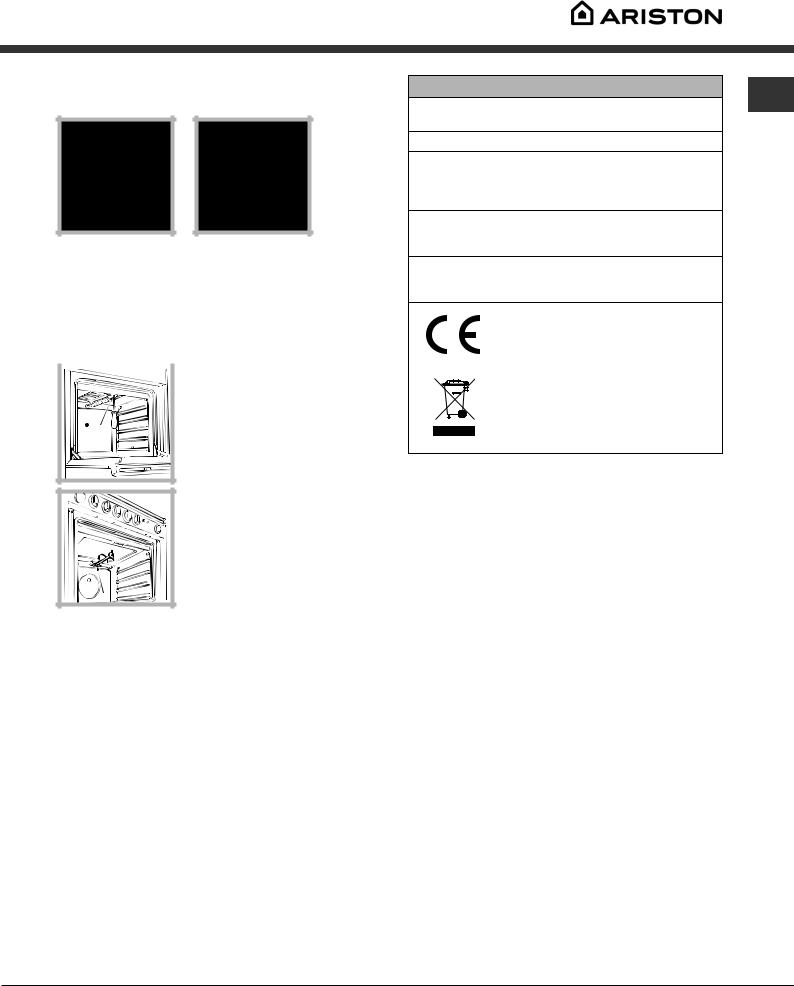
In the case of natural gas, the adjustment screw must be unscrewed by turning it anti-clockwise.
5. Turn the knob from the MAX position to the MIN position quickly or open and shut the oven door, making sure that the burner is not extinguished.
Adapting the grill
Replacing the grill burner nozzle:  1. Remove the oven burner
1. Remove the oven burner
after loosening screw V (see figure).
 V
V
I |
2. Unscrew the grill burner nozzle using a special nozzle socket spanner (see figure) or preferably with a 7 mm socket spanner, and replace it with a new nozzle that is suited to the new type of gas (see Burner and nozzle specifications table).
Be careful of the spark plug wires and the thermocouple tubes.
The oven and grill burners do not require primary air adjustment.
After adjusting the appliance so it may be used with a different type of gas, replace the old rating label with a new one that corresponds to the new type of gas (these labels are available from Authorised Technical Assistance Centres).
Should the gas pressure used be different (or vary slightly) from the recommended pressure, a suitable pressure regulator must be fitted to the inlet hose in accordance with current national regulations relating to “regulators for channelled gas”.
TECHNICAL DATA |
GB |
|
|
||
Oven Dimensions |
31x43,5x43,5 cm |
|
HxWxD |
||
|
||
Volume |
58 l |
|
Useful |
width 46 cm |
|
measurements |
||
depth 42 cm |
||
relating to the |
||
height 8,5 cm |
||
oven compartment |
||
|
||
Voltage and |
see data plate |
|
frequency |
||
|
||
|
may be adapted for use with any |
|
Burners |
type of gas shown on the data |
|
|
plate. |
|
|
EC Directives 73/23/EEC dated |
|
|
19/02/73 (Low Voltage) and |
|
|
subsequent amendments - |
|
|
89/336/EEC dated 03/05/89 |
|
|
(Electromagnetic Compatibility) |
|
|
and subsequent amendments - |
|
|
90/369/EEC dated 29/06/90 (Gas) |
|
|
and subsequent amendments - |
|
|
90/68/EEC dated 22/07/93 and |
|
|
subsequent amendments. - |
|
|
2002/96/EEC. |
5
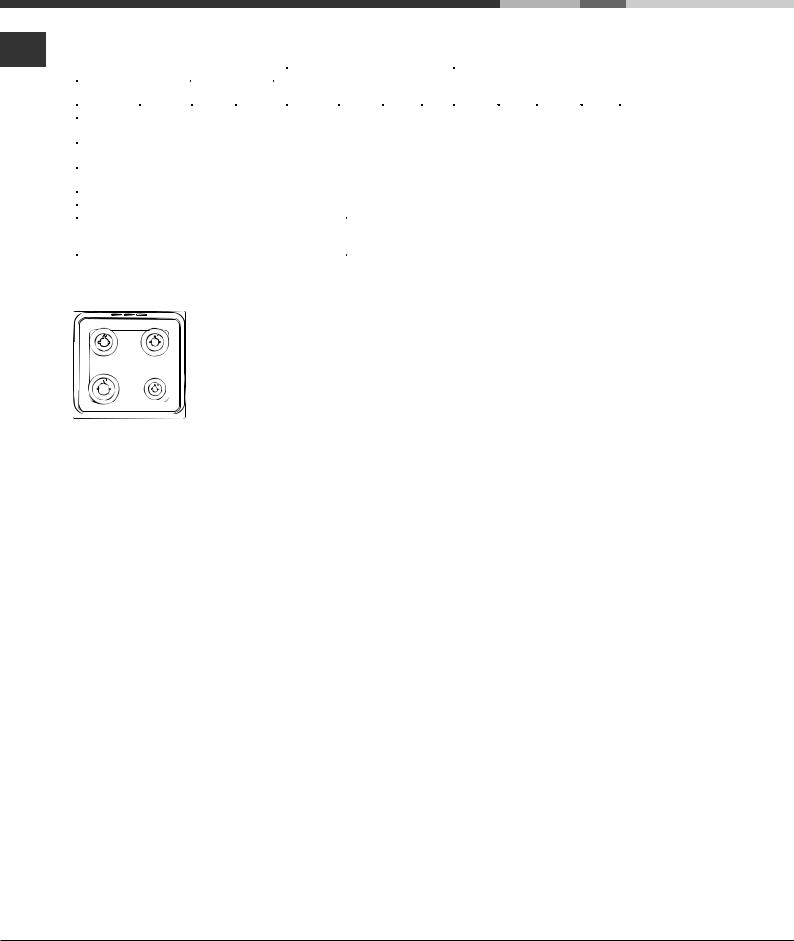
Table of burner and nozzle specifications
GB
Table 1 |
|
|
|
|
Liquid Gas |
|
|
Natural Gas |
|
|||||
Burner |
Diameter |
Thermal Power |
By Pass |
Nozzle |
Flow* |
Nozzle |
Flow* |
Nozzle |
|
Flow* |
||||
|
|
(mm) |
kW (p.c.s.*) |
1/100 |
1/100 |
g/h |
|
1/100 |
l/h |
1/100 |
|
l/h |
||
|
|
|
Nominal |
Reduced |
(mm) |
(mm) |
*** |
|
** |
(mm) |
|
(mm) |
|
|
Fast |
|
100 |
3.00 |
0.7 |
41 |
86 |
218 |
|
214 |
116 |
286 |
143 |
|
286 |
(Large)(R) |
|
|
||||||||||||
|
|
|
|
|
|
|
|
|
|
|
|
|
||
Semi Fast |
75 |
1.90 |
0.4 |
30 |
70 |
138 |
|
136 |
106 |
181 |
118 |
|
181 |
|
(Medium)(S) |
|
|
||||||||||||
|
|
|
|
|
|
|
|
|
|
|
|
|
||
Auxiliary |
55 |
1.00 |
0.4 |
30 |
50 |
73 |
|
71 |
79 |
95 |
80 |
|
95 |
|
(Small)(A) |
|
|
||||||||||||
|
|
|
|
|
|
|
|
|
|
|
|
|
||
Oven |
|
- |
2.60 |
1.0 |
52 |
78 |
189 |
|
186 |
119 |
189 |
132 |
|
238 |
Grill |
|
- |
2.50 |
- |
- |
80 |
182 |
|
179 |
122 |
238 |
139 |
|
227 |
Supply |
Nominal (mbar) |
|
|
28-30 |
|
37 |
20 |
|
13 |
|
||||
Minimum (mbar) |
|
|
20 |
|
25 |
17 |
|
6,5 |
|
|||||
Pressures |
|
|
|
|
|
|||||||||
Maximum (mbar) |
|
|
35 |
|
45 |
25 |
|
18 |
|
|||||
|
|
|
|
|
|
|
||||||||
* |
At 15°C 1013 mbar-dry gas |
*** |
Butane P.C.S. = 49,47 MJ/Kg |
|
|
|
|
|
|
|||||
** |
Propane P.C.S. = 50,37 MJ/Kg |
Natural P.C.S. = 37,78 MJ/m³ |
|
|
|
|
|
|
||||||
S S
R A
CG64SG1 EX
6

Description of the appliance
Overall view
GB
Glass cover*
Gas burner |
Containment |
|
Hob grid |
surface for spills |
|
Control panel |
GUIDE RAILS |
|
|
for the sliding racks |
|
|
position 5 |
|
GRILL rack |
position 4 |
|
DRIPPING PAN |
position 3 |
|
position 2 |
||
|
||
|
position 1 |
|
Adjustable foot |
Adjustable foot |
|
|
Control panel
OVEN LIGHT and |
GAS BURNER |
Hob BURNER |
ROTISSERIE button |
ignition button* |
control knobs |
|
|
|
|
|
|
|
|
|
|
|
|
|
|
|
|
|
|
|
|
|
|
|
|
|
|
|
|
|
OVEN |
TIMER |
||||
|
control knob |
knob* |
||||
* Only available in certain models.
7
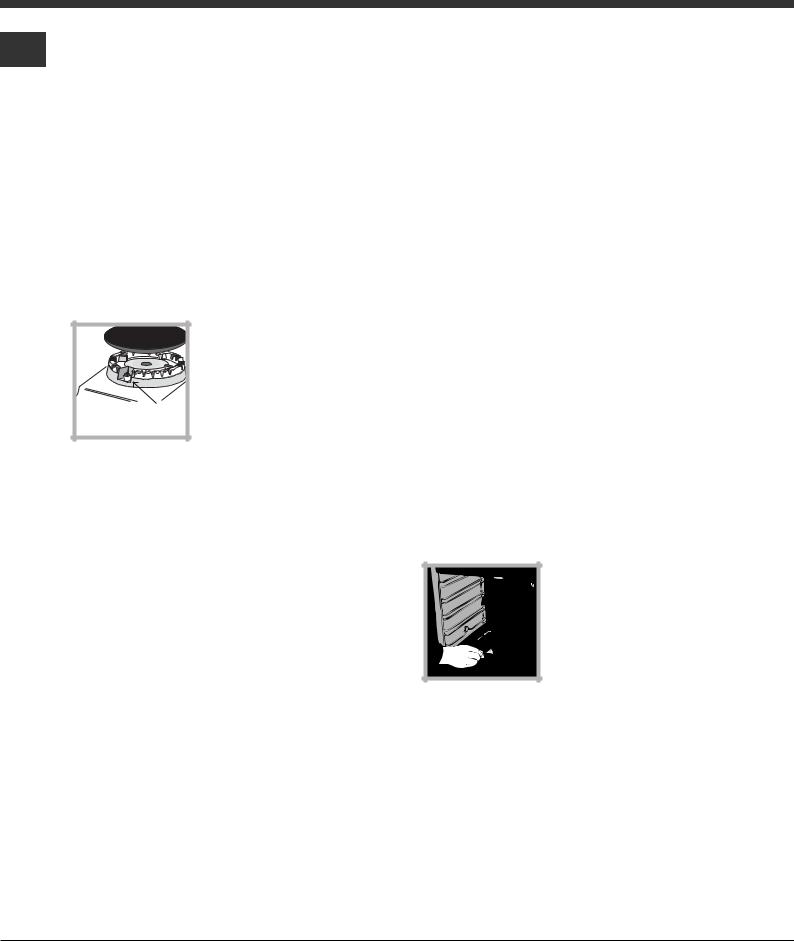
Start-up and use
Using the hob
GB
Lighting the burners
For each BURNER knob there is a complete ring showing the strength of the flame for the relevant burner.
To light one of the burners on the hob:
1.Bring a flame or gas lighter close to the burner.
2.Press the BURNER knob and turn it in an anticlockwise direction so that it is pointing to the maximum flame setting -.
3.Adjust the intensity of the flame to the desired level by turning the BURNER knob in an anticlockwise direction. This may be the minimum setting +, the maximum setting - or any position in between the two.
If the appliance is fitted with an electronic lighting device*
(see figure), press the ignition
button, marked with the
symbol , then hold the BURNER knob down and turn it in an anticlockwise direction,
towards the maximum flame setting, until the burner is lit.The burner may be extinguished when the knob is released. If this occurs, repeat the operation, holding the knob down for a longer period of time.
If the flame is accidentally extinguished, switch off the burner and wait for at least 1 minute before attempting to relight it.
If the appliance is equipped with a flame failure safety device*, press and hold the BURNER knob for approximately 2-3 seconds to keep the flame alight and to activate the device.
To switch the burner off, turn the knob until it reaches the stop position •.
Practical advice on using the burners
For the burners to work in the most efficient way possible and to save on the amount of gas consumed, it is recommended that only pans that have a lid and a flat base are used. They should also be suited to the size of the burner.
* Only available in certain models.
|
|
|
|
|
|
|
|
|
|
|
|
Burner |
ø Cookware diameter (cm) |
|
|||
|
|
|
|||
Fast (R) |
24 - 26 |
|
|||
|
|
|
|||
Semi Fast (S) |
16 - 20 |
|
|||
|
|
|
|||
Auxiliary (A) |
10 - 14 |
|
|||
|
|
|
|
|
|
To identify the type of burner, please refer to the diagrams contained in the “Burner and nozzle specifications”.
On the models supplied with a reducer shelf, remember that this should be used only for the auxiliary burner when you use casserole dishes with a diameter under 12 cm.
Using the oven
The first time you use your appliance, heat the empty oven with its door closed at its maximum temperature for at least half an hour. Ensure that the room is well ventilated before switching the oven off and opening the oven door. The appliance may emit a slightly unpleasant odour caused by protective substances used during the manufacturing process burning away.
Never put objects directly on the bottom of the oven; this will avoid the enamel coating being damaged. Only use position 1 in the oven when cooking with the rotisserie spit.
Lighting the oven
To light the oven burner, bring a flame or gas lighter close to opening F (see figure) and press the OVEN control knob while turning it in an anticlockwise direction until it reaches the MAX position.
If the appliance is fitted with an electronic lighting device* (see figure), press the ignition button,
marked with the symbol , then hold the OVEN control knob and turn it in an anticlockwise direction, towards the MAX position, until the burner is lit. If, after 15 seconds, the burner is still not alight, release the knob, open the oven door and wait for at least 1 minute before trying to light it again. If there is no electricity the burner may be lit using a flame or a lighter, as described above.
The oven is fitted with a safety device and it is therefore necessary to hold the OVEN control knob
8

down for approximately 6 seconds.
If the flame is accidentally extinguished, switch off the burner and wait for at least 1 minute before attempting to relight the oven.
Adjusting the temperature
To set the desired cooking temperature, turn the OVEN control knob in an anticlockwise direction. Temperatures are displayed on the control panel and may vary between MIN (150°C) and MAX (250°C). Once the set temperature has been reached, the oven will keep it constant by using its thermostat.
Grill
To light the grill, bring a flame or gas lighter close to the burner and press the OVEN control knob while turning it in a clockwise direction until it reaches the @ position. The grill enables the surface of food to be browned evenly and is particularly suitable for roast dishes, schnitzel and sausages. Place the rack in position 4 or 5 and the dripping pan in position 1 to collect fat and prevent the formation of smoke.
The grill is fitted with a safety device and it is therefore necessary to hold the OVEN control knob down for approximately 6 seconds.
If the flame is accidentally extinguished, switch off the burner and wait for at least 1 minute before attempting to relight the grill.
D |
When using the grill, leave the oven door ajar, positioning the deflector D between the door and the control panel (see figure) in order to prevent the knobs from overheating.
Turnspit |
GB
To operate the rotisserie (see diagram) proceed as follows:
1.Place the dripping pan in position 1.
2.Place the rotisserie support in position 4 and insert the spit in the hole provided on the back panel of the oven.
3. Acitvate the function by pressing the TURNSPIT button.
Oven light
The light may be switched on at any moment by pressing the OVEN LIGHT button.
Timer*
To activate the Timer proceed as follows:
1.Turn the TIMER knob in a clockwise direction " for almost one complete revolution to set the buzzer.
2.Turn the TIMER knob in an anticlockwise direction
# to set the desired length of time.
* Only available in certain models.
9

|
|
|
|
|
|
|
|
|
|
|
|
|
Oven cooking advice table |
|
|
|
|
|
|
|
|
|
|
GB |
|
|
|
|
|
|
|
|
|
||
|
|
|
|
|
|
|
|
|
|
|
|
|
|
|
|
|
|
|
|
|
|
|
|
|
|
Foods |
Weight (in |
Rack |
Preheating time (min) |
Recommended |
Cooking time |
|
|||
|
|
|
kg) |
position |
|
|
Temperature (°C) |
(minutes) |
|
||
|
|
Pasta |
2.5 |
3 |
10 |
|
210 |
|
60-75 |
|
|
|
|
Lasagne |
|
|
|
||||||
|
|
Cannelloni |
2.5 |
3 |
10 |
|
200 |
|
40-50 |
|
|
|
|
Gratin dishes |
2.5 |
3 |
10 |
|
200 |
|
40-50 |
|
|
|
|
Meat |
|
|
|
|
|
|
|
|
|
|
|
Veal |
1.7 |
3 |
10 |
|
200 |
|
85-90 |
|
|
|
|
Chicken |
1.5 |
3 |
10 |
|
220 |
|
90-100 |
|
|
|
|
Duck |
1.8 |
3 |
10 |
|
200 |
|
100-110 |
|
|
|
|
Rabbit |
2 |
3 |
10 |
|
200 |
|
70-80 |
|
|
|
|
Pork |
2.1 |
3 |
10 |
|
200 |
|
70-80 |
|
|
|
|
Lamb |
1.8 |
3 |
10 |
|
200 |
|
90-95 |
|
|
|
|
Fish |
|
|
|
|
|
|
|
|
|
|
|
Mackerel |
1.1 |
3 |
10 |
|
180-200 |
|
35-40 |
|
|
|
|
Dentex |
1.5 |
3 |
10 |
|
180-200 |
|
40-50 |
|
|
|
|
Trout baked in foil |
1 |
3 |
10 |
|
180-200 |
|
40-45 |
|
|
|
|
Pizza |
|
|
|
|
|
|
|
|
|
|
|
Neapolitan-style |
1 |
3 |
15 |
|
220 |
|
15-20 |
|
|
|
|
Pies |
|
|
|
|
|
|
|
|
|
|
|
Biscuits |
0.5 |
3 |
15 |
|
180 |
|
30-35 |
|
|
|
|
Tart |
1.1 |
3 |
15 |
|
180 |
|
30-35 |
|
|
|
|
Savoury pies |
1 |
3 |
15 |
|
180 |
|
45-50 |
|
|
|
|
Leavened cakes |
1 |
3 |
15 |
|
180 |
|
35-40 |
|
|
|
|
Grilled foods |
|
|
|
|
|
|
|
|
|
|
|
Veal steak |
1 |
4 |
5 |
|
|
|
|
15-20 |
|
|
|
Cutlets |
1.5 |
4 |
5 |
|
|
|
|
20 |
|
|
|
Hamburgers |
1 |
3 |
5 |
|
|
|
|
7 |
|
|
|
Mackerel |
1 |
4 |
5 |
|
|
|
|
15-20 |
|
|
|
Toast |
4 pcs |
4 |
5 |
|
|
|
|
5 |
|
|
|
Grillling using the rotisserie |
|
|
|
|
|
|
|
|
|
|
|
Spit-roast veal |
1 |
- |
5 |
|
|
|
|
70-80 |
|
|
|
Spit-roast chicken |
2 |
- |
5 |
|
|
|
|
70-80 |
|
|
|
Grillling using the multi-spit rotisserie* |
|
|
|
|
|
|
|
|
|
|
|
Meat kebabs |
1 |
- |
5 |
|
|
|
|
40-45 |
|
|
|
Vegetable kebabs |
0.8 |
- |
5 |
|
|
|
|
25-30 |
|
10

Precautions and tips
This appliance has been designed and manufactured in compliance with international safety standards.
The following warnings are provided for safety reasons and must be read carefully.
General safety
•The appliance was designed for domestic use inside the home and is not intended for commercial or industrial use.
•The appliance must not be installed outdoors, even in covered areas. It is extremely dangerous to leave the appliance exposed to rain and storms.
•Do not touch the appliance with bare feet or with wet or damp hands and feet.
•The appliance must be used by adults only for the preparation of food, in accordance with the instructions provided in this booklet (the instructions apply to all countries listed at the beginning of the booklet).
•The instruction booklet accompanies a class 1 (insulated) or class 2 - subclass 1 (recessed between 2 cupboards) appliance.
•When the appliance is in use, the heating elements and some parts of the oven door become extremely hot. Make sure you don't touch them and keep children well away.
•Make sure that the power supply cables of other electrical appliances do not come into contact with the hot parts of the oven.
•The openings used for the ventilation and dispersion of heat must never be covered.
•Do not close the glass hob cover (selected models only) when the burners are alight or when they are still hot.
•Always use oven gloves when placing cookware in the oven or when removing it.
•Do not use flammable liquids (alcohol, petrol, etc...) near the appliance while it is in use.
•Do not place flammable material in the lower storage compartment or in the oven itself. If the appliance is switched on accidentally, it could catch fire.
• The internal surfaces of the compartment (where |
GB |
|
present) may become hot. |
||
|
||
|
|
•Always make sure the knobs are in the • position and that the gas tap is closed when the appliance is not in use.
•When unplugging the appliance, always pull the plug from the mains socket; do not pull on the cable.
•Never perform any cleaning or maintenance work without having disconnected the appliance from the electricity mains.
•If the appliance breaks down, under no circumstances should you attempt to repair the appliance yourself. Repairs carried out by inexperienced persons may cause injury or further malfunctioning of the appliance. Contact Assistance.
•Do not rest heavy objects on the open oven door.
Disposal
•When disposing of packaging material: observe local legislation so that the packaging may be reused.
•The European Directive 2002/96/EC on Waste Electrical and Electronic Equipment (WEEE), requires that old household electrical appliances must not be disposed of in the normal unsorted municipal waste stream. Old appliances must be collected separately in order to optimise the recovery and recycling of the materials they contain and reduce the impact on human health and the environment. The crossed out “wheeled bin” symbol on the product reminds you of your obligation, that when you dispose of the appliance it must be separately collected.
Consumers should contact their local authority or retailer for information concerning the correct disposal of their old appliance.
Respecting and conserving the environment
•You can help to reduce the peak load of the electricity supply network companies by using the oven in the hours between late afternoon and the early hours of the morning.
•Always keep the oven door closed when using the GRILL mode This will achieve better results while saving energy (approximately 10%).
•Check the door seals regularly and wipe them clean to ensure they are free of debris so that they adhere properly to the door, thus avoiding heat dispersion.
11

Care and maintenance
Switching the appliance off
GB
Disconnect your appliance from the electricity supply before carrying out any work on it.
Cleaning the appliance
Never use steam cleaners or pressure cleaners on the appliance.
•The stainless steel or enamel-coated external parts and the rubber seals may be cleaned using a sponge that has been soaked in lukewarm water and neutral soap. Use specialised products for the removal of stubborn stains. After cleaning, rinse well and dry thoroughly. Do not use abrasive powders or corrosive substances.
•The hob grids, burner caps, flame spreader rings and burners may be removed to make cleaning easier; wash them in hot water and non-abrasive detergent, making sure all burnt-on residue is removed before drying them thoroughly.
•Clean the terminal part of the flame failure safety devices* frequently.
•The inside of the oven should ideally be cleaned after each use, while it is still lukewarm. Use hot water and detergent, then rinse well and dry with a soft cloth. Do not use abrasive products.
•Clean the glass part of the oven door using a sponge and a non-abrasive cleaning product, then dry thoroughly with a soft cloth. Do not use rough abrasive material or sharp metal scrapers as these could scratch the surface and cause the glass to crack.
•The accessories can be washed like everyday crockery, and are even dishwasher safe.
•Do not close the cover when the burners are alight or when they are still hot.
Inspecting the oven seals
Check the door seals around the oven regularly. If the seals are damaged, please contact your nearest Authorised After-sales Service Centre. We recommend that the oven is not used until the seals have been replaced.
Replacing the oven light bulb
1. After disconnecting the oven from the electricity mains, remove the glass lid covering
the lamp socket (see figure).
2. Remove the light bulb and replace it with a similar one:
voltage 230 V, wattage 25 W, cap E 14.
3. Replace the lid and reconnect the oven to the electricity supply.
Gas tap maintenance
Over time, the taps may become jammed or difficult to turn. If this happens, the tap must be replaced.
This procedure must be performed by a qualified technician authorised by the manufacturer.
Assistance
Never use the services of an unauthorised technician.
Please have the following information to hand:
•The type of problem encountered.
•The appliance model (Mod.).
•The serial number (S/N).
The latter two pieces of information can be found on the data plate located on the appliance.
* Only available in certain models.
12

Mode d’emploi
|
GB |
|
FR |
|
ES |
|
|
|
|
|
|
|
|
|
|
|
|
|
|
Français, 13 |
|
|
|
|
English, 1 |
Espanol, 25 |
|||||
|
|
|
|
|
|
|
|
|
GB |
|
AR |
|
|
|
|
|
|
|
|
|
|
|
|
English, 37 |
|
|
|
|
|||
CG64SG1 EX
CUISINIERE
Sommaire
FR
Installation, 14-18
Positionnement et nivellement Raccordement électrique Raccordement gaz
Adaptation aux différents types de gaz Caractéristiques techniques
Tableau Caractéristiques des brûleurs et des injecteurs
Description de l’appareil, 19
Vue d’ensemble
Tableau de bord
Mise en marche et utilisation, 20-22
Utilisation du plan de cuisson
Utilisation du four
Tableau de cuisson
Précautions et conseils, 23
Sécurité générale
Mise au rebut
Economies et respect de l’environnement
Nettoyage et entretien, 24
Mise hors tension Nettoyage de l’appareil Entretien robinets gaz
Remplacement de l’ampoule d’éclairage du four Assistance

Installation
Conservez ce mode d’emploi pour pouvoir le
FR consulter à tout moment. En cas de vente, de cession ou de déménagement, veillez à ce qu’il suive l’appareil.
Lisez attentivement les instructions : elles contiennent des conseils importants sur l’installation, l’utilisation et la sécurité de votre appareil.
L’installation de l’appareil doit être effectuée par un professionnel du secteur conformément aux instructions du fabricant.
N’importe quelle opération de réglage, d’entretien, etc., doit être effectuée après avoir débranché la prise de la cuisinière.
Conditions réglementaires d’installation
Le raccordement gaz devra être fait par un professionnel qualifié qui assurera la bonne alimentation en gaz et le meilleur réglage de la combustion des brûleurs. Ces opérations d’installation, quoique simples, sont délicates et primordiales pour que votre cuisinière vous rende le meilleur service. L’installation doit être effectuée conformément aux textes réglementaires et règles de l’art en vigueur, notamment:
•Arrêté du 2 août 1977. Règles techniques et de sécurité applicables aux installations de gaz combustibles et d’hydro-carbures liquéfiés situées
àl’intérieur des bâtiments d’habitation et de leur dépendances.
•Norme DTU P45-204. Installations de gaz (anciennement DTU n° 61-1-installations de gaz - Avril 1982 + additif n°1 Juillet 1984).
•Règlement sanitaire départemental.
Aération des locaux
L’appareil doit être installé dans des locaux qui sont aérés en permanence, selon les prescriptions des Normes en vigueur dans le pays d’installation. Il est indispensable que la pièce où l’appareil est installé dispose d’une quantité d’air égale à la quantité d’air comburant nécessaire à une bonne combustion du gaz (le flux d’air doit être d’au moins 3 m3/h par kW de puissance installée).
Les prises d’air, protégées par des grilles, doivent disposer d’un conduit d’au moins 2 cm2 de section utile et dans une position qui leur évite tout risque d’être bouchées accidentellement, même partiellement (voir figure A).
Ces ouvertures doivent être agrandies de 100% (surface minimale 2 cm2) en cas d’appareils dépourvus du dispositif de sécurité de flamme et quand l’afflux de l’air provient de manière indirecte de
pièces voisines (voir figure B) – à condition qu’il ne s’agisse pas de parties communes du bâtiment, de chambres à coucher ou de locaux à risque d’incendie
– équipées d’un conduit d’aération avec l’extérieur comme décrit plus haut.
Local adjacent |
|
|
|
|
|
|
|
|
Local à ventiler |
||||
A |
|
|
|
|
|
B |
|||||||
|
|
|
|
|
|
|
|
|
|
|
|
|
|
|
|
|
|
|
|
|
|
|
|
|
|
|
|
|
|
|
|
|
|
|
|
|
|
|
|
|
|
|
|
|
|
|
|
|
|
|
|
|
|
|
|
|
|
|
|
|
|
|
|
|
|
|
|
|
|
A
|
|
|
|
|
|
|
|
|
|
|
|
|
|
|
|
|
|
|
|
|
|
|
|
Ouverture de ventilation |
Agrandissement de la |
||||||
pour l’air comburant |
fissure entre la porte et |
||||||
|
|
|
|
|
le sol |
||
Après une utilisation prolongée de l’appareil, il est conseillé d’ouvrir une fenêtre ou d’augmenter la vitesse de ventilateurs éventuels.
Evacuation des fumées de combustion
La pièce doit prévoir un système d’évacuation vers l’extérieur des fumées de combustion réalisé au moyen d’une hotte reliée à une cheminée à tirage naturel ou par ventilateur électrique qui entre automatiquement en fonction dès qu’on allume l’appareil (voir figures).
|
|
|
|
|
|
|
|
|
|
|
|
|
|
|
|
|
|
|
|
|
|
|
|
|
|
|
|
|
|
|
|
|
|
|
|
|
|
|
|
|
|
|
|
|
|
|
|
|
|
|
|
|
|
|
|
|
|
|
|
|
|
|
|
|
|
|
|
|
|
|
|
|
|
|
|
|
|
|
|
|
|
|
|
|
|
|
|
|
|
|
|
|
|
|
|
|
|
|
|
|
|
|
|
|
|
|
|
|
|
|
|
|
|
|
|
|
|
|
|
|
|
|
|
|
|
|
|
|
|
|
|
|
|
|
|
|
|
|
|
|
|
|
|
|
|
|
|
|
|
|
|
|
|
|
|
|
|
|
|
|
|
|
Evacuation |
|
Evacuation par cheminée ou |
||||||||||||||
directement à |
conduit de fumée ramifié (réservé |
||||||||||||||||
|
l’extérieur |
aux appareils de cuisson) |
|||||||||||||||
Les gaz de pétrole liquéfiés, plus lourds que l’air, se déposent et stagnent dans le bas. Les locaux qui contiennent des bouteilles de G.P.L doivent donc prévoir des ouvertures vers l’extérieur afin de permettre l’évacuation du gaz par le bas en cas de fuites accidentelles. Ne pas installer ou entreposer de bouteilles de GPL, vides ou partiellement pleines, dans des locaux qui se trouvent en sous-sol (caves etc.). Ne gardez dans la pièce que la bouteille que vous êtes en train d’utiliser, loin de sources de chaleur (fours, feux de bois, poêles etc.) qui pourraient amener sa température à plus de 50°C.
"
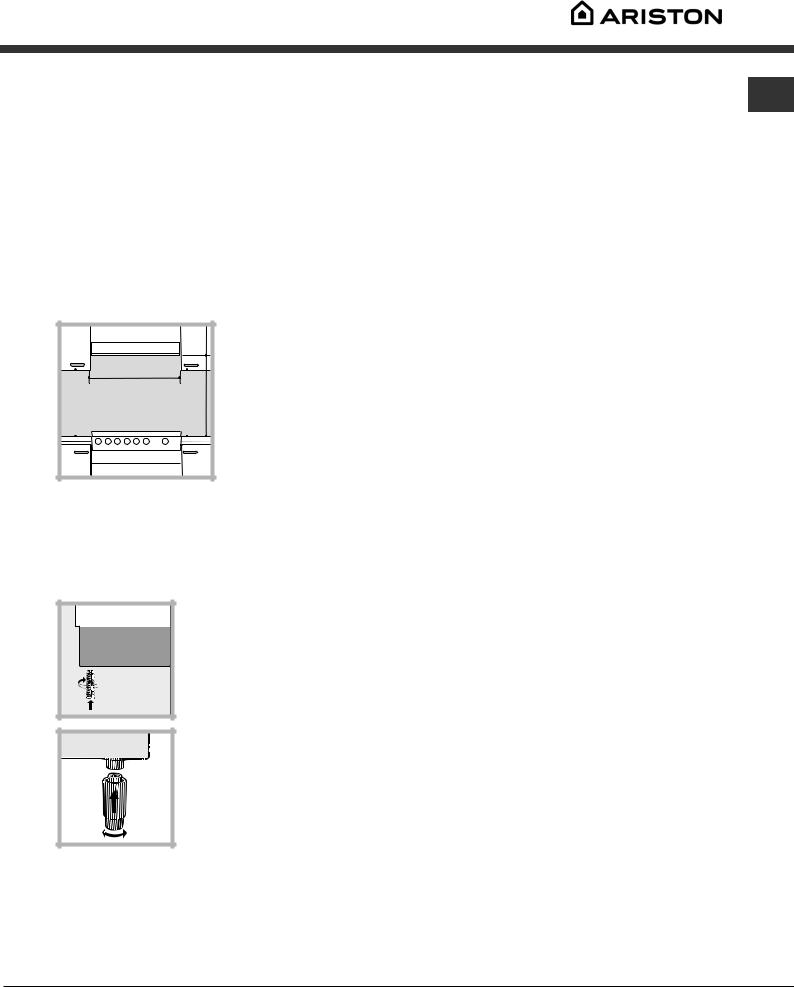
Positionnement et nivellement
L’appareil peut être installé à côté de meubles dont la hauteur ne dépasse pas celle du plan de cuisson.
Assurez-vous que le mur en contact avec la paroi arrière de l’appareil est réalisée en matériel ignifuge résistant à la chaleur (T 90°C).
Pour une installation correcte :
•installez cet appareil dans une cuisine, une salle à manger ou un studio (jamais dans une salle de bains);
•si le plan de cuisson de la cuisinière dépasse le
plan de travail des meubles, ces derniers doivent être placés à au moins 200 mm de l’appareil;
|
|
|
|
• si la cuisinière est |
|
HOOD |
|
|
|
installée sous un |
|
|
|
|
élément suspendu, il |
||
|
|
|
|
||
Min. 600mm. |
Min. 420mm. |
min. 650 mm. with hood |
min. 700 mm. without hood |
faut que ce dernier soit |
|
Min. 420mm. |
placé à au moins 420mm |
||||
de distance du plan. Il |
|||||
faut prévoir une distance |
|||||
de 700mm si les |
|||||
|
|
|
|
||
|
|
|
|
éléments suspendus sont |
|
|
|
|
|
inflammables (voir |
|
|
|
|
|
figure); |
•ne placez pas de rideaux derrière la cuisinière ou sur ses côtés à moins de 200 mm de distance;
•pour l’installation de hottes, conformez-vous aux
instructions de leur notice d’emploi.
Nivellement |
Pour mettre l’appareil bien à plat, vissez les pieds de réglage fournis aux emplacements prévus aux coins à la base de la cuisinière (voir figure).
Montage des pieds* par encastrement sous la base.
Raccordement électrique
Montez sur le câble une prise normalisée pour la charge indiquée sur l’étiquette des caractéristiques (voir tableau des caractéristiques techniques).
En cas de raccordement direct au réseau, il faut
intercaler entre l’appareil et le réseau un interrupteur à coupure omnipolaire ayant au moins 3 mm FR d’écartement entre les contacts, dimensionné à la
charge et conforme aux normes en vigueur (le fil de terre ne doit pas être interrompu par l’interrupteur). Le câble d’alimentation ne doit atteindre, en aucun point, des températures dépassant de 50°C la température ambiante.
Avant de procéder au branchement, assurez-vous que :
•la prise est bien munie d’une terre conforme à la loi;
•la prise est bien apte à supporter la puissance maximale de l’appareil, indiquée sur la plaquette signalétique;
•la tension d’alimentation est bien comprise entre les valeurs indiquées sur la plaquette signalétique;
•la prise est bien compatible avec la fiche de l’appareil. Si ce n’est pas le cas, remplacez la prise ou la fiche, n’utilisez ni rallonges ni prises multiples.
Après installation de l’appareil, le câble électrique et la prise de courant doivent être facilement accessibles
Le câble ne doit être ni plié ni excessivement écrasé.
Le câble doit être contrôlé périodiquement et ne peut être remplacé que par un technicien agréé.
Nous déclinons toute responsabilité en cas de non respect des normes énumérées ci-dessus.
Raccordement gaz
Pour raccorder l’appareil au réseau de distribution du gaz ou à la bouteille de gaz utilisez un tuyau flexible en caoutchouc ou en acier, conformément à la réglementation en vigueur. Assurez-vous auparavant que l’appareil est bien réglé pour le type de gaz d’alimentation utilisé (voir étiquette sur le couvercle : autrement voir ci-dessous). Si l’alimentation s’effectue avec du gaz liquide en bouteille, utilisez des régulateurs de pression conformes à la réglementation en vigueur dans le pays. Pour simplifier le raccordement, l’alimentation du gaz est orientable latéralement* : inversez l’about annelé avec le bouchon de fermeture et remplacez le joint d’étanchéité (fourni avec l’appareil).
Pour un fonctionnement en toute sécurité, pour un meilleur emploi de l’énergie et une plus longue durée de vie de l’appareil, vérifiez que la pression d’alimentation respecte bien les valeurs indiquées dans le tableau Caractéristiques des brûleurs et des injecteurs (voir ci-dessous).
*N’existe que sur certains modèles
#
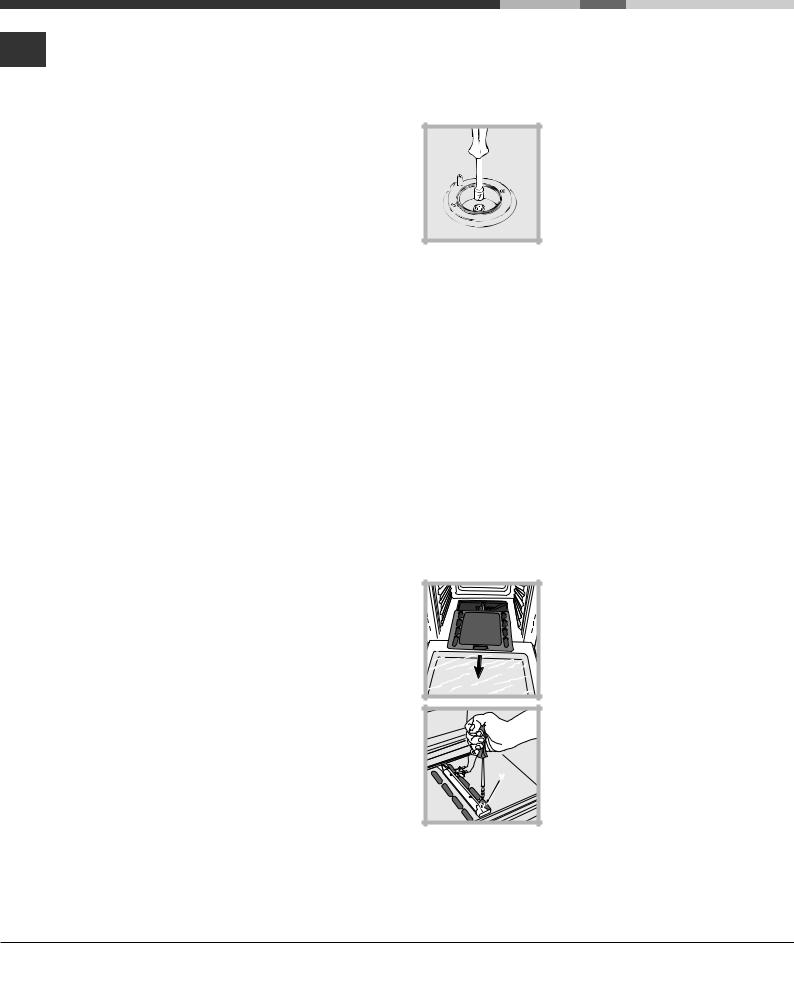
Raccordement gaz par tuyau flexible en caoutchouc
FR
Assurez-vous que le tuyau est bien conforme aux normes applicables dans le pays d’installation. Le tuyau doit avoir un diamètre intérieur de : 8 mm en cas d’alimentation au gaz liquide; 15 mm en cas d’alimentation au gaz naturel.
Après avoir effectué le raccordement, assurez-vous que le tuyau :
•ne touche en aucun point à des parties pouvant atteindre plus de 50°C;
•ne soit pas soumis à traction ou torsion et ne présente pas de pliures ou étranglements;
•ne risque pas d’entrer en contact avec des corps tranchants, des arêtes vives, des parties mobiles et ne soit pas écrasé;
•puisse être facilement contrôlable sur toute sa longueur pour vérifier son état de conservation;
•ait moins de 1500mm de long;
•soit bien fixé à ses deux extrémités à l’aide de bagues de serrage conformes à la réglementation en vigueur dans le pays.
Si une ou plusieurs de ces conditions ne peuvent être remplies ou que la cuisinière est installée dans des conditions de classe 2 – sous-classe 1 (appareil encastré entre deux meubles), il faut utiliser un tuyau flexible en acier (voir ci-dessous).
Raccordement gaz par tuyau flexible en acier inox, à paroi continue avec raccords filetés
Assurez-vous que le tuyau et les joints sont bien conformes aux normes applicables dans le pays d’installation.
Pour installer le tuyau, enlevez l’about annelé équipant l’appareil (le raccord d’entrée du gaz à l’appareil est fileté 1/2 gaz mâle cylindrique).
Procédez au raccordement de manière à ce que la longueur du tuyau ne dépasse pas 2 mètres d’extension maximale. Veillez à ce que le tuyau ne soit pas écrasé et ne touche en aucun point à des parties mobiles.
Vérification de l’étanchéité
Une fois l’installation terminée, vérifiez l’étanchéité de tous les raccords en utilisant une solution savonneuse, n’utilisez jamais de flamme.
Adaptation aux différents types de gaz
L’appareil peut être adapté à un type de gaz autre que celui pour le quel il a été conçu (indiqué sur l’étiquette de réglage sur le couvercle).
Adaptation du plan de cuisson
Remplacement des injecteurs des brûleurs du plan de cuisson:
1.enlevez les grilles du plan de cuisson et sortez les brûleurs de leur logement;
2. dévissez les injecteurs à l’aide d’une clé à tube de 7mm (voir figure), et remplacez-les
par les injecteurs adaptés au
nouveau type de gaz (voir tableau Caractéristiques des brûleurs et des injecteurs) ;
3.remontez les différentes parties en effectuant les opérations dans le sens inverse.
Réglage des minima des brûleurs du plan de cuisson :
1.placez le robinet sur la position minimum; 2.enlevez le bouton et tournez la vis de réglage positionnée à l’intérieur ou sur le côté de la tige du robinet jusqu’à obtenir une petite flamme régulière;
En cas de gaz naturel, il faut dévisser la vis de réglage en tournant dans le sens inverse des aiguilles d’une montre;
3.vérifiez si, en tournant rapidement le robinet du maximum au minimum, le brûleur ne s’éteint pas.
Les brûleurs du plan de cuisson ne nécessitent pas de réglage de l’air primaire.
Adaptation du four
Remplacement du brûleur du four:
1. ouvrez complètement la porte du four;
2. enlever la protection
coulissante (voir figure);
V |
3. déposer le brûleur du four après avoir enlevé la vis V (voir figure);
$
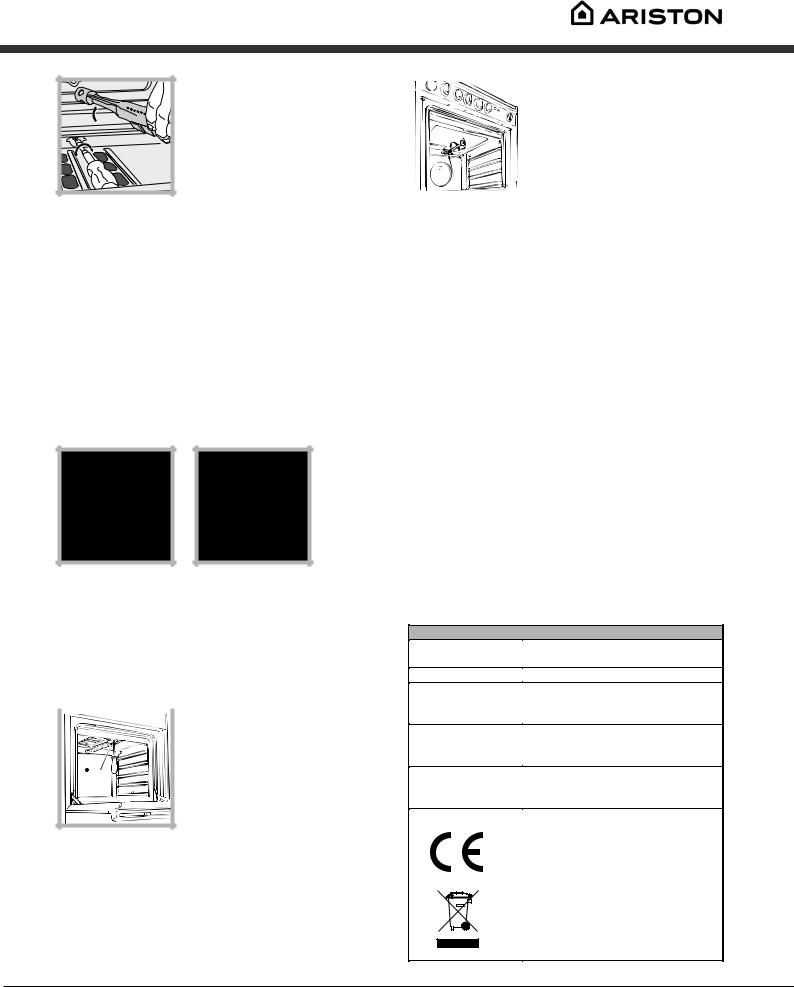
4. dévisser l’injecteur du brûleur à l’aide de la clé à tube spéciale pour injecteurs (voir figure) ou d’une clé à tube de 7 mm et le remplacer par l’injecteur adapté au nouveau type de gaz (voir tableau Caractéristiques des brûleurs et des injecteurs).
Réglage du minimum du brûleur du four à gaz :
1.allumer le brûleur (voir Mise en marche et Utilisation);
2.amener la manette sur la position minimum (MIN) après l’avoir laissée pendant environ 10 minutes sur la position maximum (MAX);
3.enlever le bouton;
4.agir sur la vis de réglage positionnée à l’extérieur de la tige du thermostat (voir figure) jusqu’à obtenir une petite flamme régulière.
En cas de gaz naturel, il faut dévisser la vis de réglage en tournant dans le sens inverse des aiguilles d’une montre;
5. vérifier si, en tournant rapidement le bouton de la position MAX à la position MIN, ou en ouvrant et fermant rapidement la porte du four, le brûleur ne s’éteint pas.
Adaptation du gril
Remplacement de l'injecteur du brûleur du gril :  1. déposer le brûleur du gril
1. déposer le brûleur du gril
après avoir enlevé la vis V (voir figure);
 V
V
|
2. dévisser l'injecteur du |
FR |
|
brûleur du gril à l'aide de la clé |
|
|
|
|
|
à tube adaptée pour les |
|
|
|
|
|
injecteurs (voir Figure), ou |
|
|
mieux encore avec une clé à |
|
|
tube de 7 mm. et le remplacer |
|
I |
par celui adapté au nouveau |
|
|
|
|
|
type de gaz (voir tableau |
|
|
|
|
Caractéristiques brûleurs et injecteurs). |
|
|
Les brûleurs du four et du gril ne nécessitent pas de réglage de l'air primaire.
Faire très attention aux câbles des bougies et aux tuyaux des thermocouples.
Après avoir procédé au réglage pour le nouveau type de gaz, remplacer la vieille étiquette par celle correspondant au nouveau gaz, disponible dans les centres d’assistance technique agréés.
Si la pression du gaz diffère (ou varie) par rapport à la pression prévue, il faut installer, sur la tuyauterie d’entrée un régulateur de pression approprié conforme à la réglementation sur les “régulateurs pour gaz canalisés” en vigueur dans le pays.
CARACTERISTIQUES TECHNIQUES |
||
Dimensions ıdu |
31x43,5x43,5 cm |
|
Four HxLxP |
||
|
||
Volume |
58 l |
|
Dimensions utiles |
largeur 46 cm |
|
du tiroir chauffe- |
profondeur 42 cm |
|
plats |
hauteur 8,5 cm |
|
Tension et |
voir plaquette signalétique |
|
fréquence |
||
d’alimentation : |
|
|
|
adaptables à n'importe quel type de |
|
Brûleurs |
gaz parmi ceux indiqués sur le |
|
|
plaquette signalétique |
|
|
Directives Communautaires |
|
|
73/23CEE du 19/02/73 (Basse |
|
|
Tension) et modifications suivantes |
|
|
- 89/336/CEE du 03/05/89 |
|
|
(Compatibilité Electromagnétique) |
|
|
et modifications suivantes - |
|
|
90/369/CEE du 29/06/90 (Gaz) et |
|
|
modifications suivantes - |
|
|
93/68/CEE du 22/07/93 et |
|
|
modifications suivantes - |
|
|
2002/96/CE |
|
%
